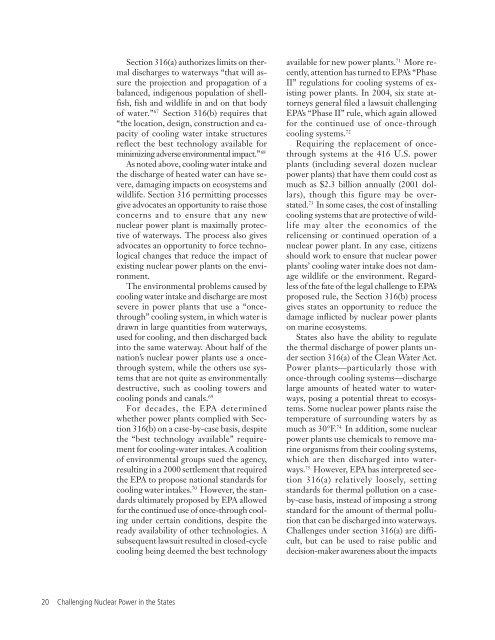Download Report (PDF) - CalPIRG
Download Report (PDF) - CalPIRG
Download Report (PDF) - CalPIRG
You also want an ePaper? Increase the reach of your titles
YUMPU automatically turns print PDFs into web optimized ePapers that Google loves.
Section 316(a) authorizes limits on thermal<br />
discharges to waterways “that will assure<br />
the projection and propagation of a<br />
balanced, indigenous population of shellfish,<br />
fish and wildlife in and on that body<br />
of water.” 67 Section 316(b) requires that<br />
“the location, design, construction and capacity<br />
of cooling water intake structures<br />
reflect the best technology available for<br />
minimizing adverse environmental impact.” 68<br />
As noted above, cooling water intake and<br />
the discharge of heated water can have severe,<br />
damaging impacts on ecosystems and<br />
wildlife. Section 316 permitting processes<br />
give advocates an opportunity to raise those<br />
concerns and to ensure that any new<br />
nuclear power plant is maximally protective<br />
of waterways. The process also gives<br />
advocates an opportunity to force technological<br />
changes that reduce the impact of<br />
existing nuclear power plants on the environment.<br />
The environmental problems caused by<br />
cooling water intake and discharge are most<br />
severe in power plants that use a “oncethrough”<br />
cooling system, in which water is<br />
drawn in large quantities from waterways,<br />
used for cooling, and then discharged back<br />
into the same waterway. About half of the<br />
nation’s nuclear power plants use a oncethrough<br />
system, while the others use systems<br />
that are not quite as environmentally<br />
destructive, such as cooling towers and<br />
cooling ponds and canals. 69<br />
For decades, the EPA determined<br />
whether power plants complied with Section<br />
316(b) on a case-by-case basis, despite<br />
the “best technology available” requirement<br />
for cooling-water intakes. A coalition<br />
of environmental groups sued the agency,<br />
resulting in a 2000 settlement that required<br />
the EPA to propose national standards for<br />
cooling water intakes. 70 However, the standards<br />
ultimately proposed by EPA allowed<br />
for the continued use of once-through cooling<br />
under certain conditions, despite the<br />
ready availability of other technologies. A<br />
subsequent lawsuit resulted in closed-cycle<br />
cooling being deemed the best technology<br />
available for new power plants. 71 More recently,<br />
attention has turned to EPA’s “Phase<br />
II” regulations for cooling systems of existing<br />
power plants. In 2004, six state attorneys<br />
general filed a lawsuit challenging<br />
EPA’s “Phase II” rule, which again allowed<br />
for the continued use of once-through<br />
cooling systems. 72<br />
Requiring the replacement of oncethrough<br />
systems at the 416 U.S. power<br />
plants (including several dozen nuclear<br />
power plants) that have them could cost as<br />
much as $2.3 billion annually (2001 dollars),<br />
though this figure may be overstated.<br />
73 In some cases, the cost of installing<br />
cooling systems that are protective of wildlife<br />
may alter the economics of the<br />
relicensing or continued operation of a<br />
nuclear power plant. In any case, citizens<br />
should work to ensure that nuclear power<br />
plants’ cooling water intake does not damage<br />
wildlife or the environment. Regardless<br />
of the fate of the legal challenge to EPA’s<br />
proposed rule, the Section 316(b) process<br />
gives states an opportunity to reduce the<br />
damage inflicted by nuclear power plants<br />
on marine ecosystems.<br />
States also have the ability to regulate<br />
the thermal discharge of power plants under<br />
section 316(a) of the Clean Water Act.<br />
Power plants—particularly those with<br />
once-through cooling systems—discharge<br />
large amounts of heated water to waterways,<br />
posing a potential threat to ecosystems.<br />
Some nuclear power plants raise the<br />
temperature of surrounding waters by as<br />
much as 30°F. 74 In addition, some nuclear<br />
power plants use chemicals to remove marine<br />
organisms from their cooling systems,<br />
which are then discharged into waterways.<br />
75 However, EPA has interpreted section<br />
316(a) relatively loosely, setting<br />
standards for thermal pollution on a caseby-case<br />
basis, instead of imposing a strong<br />
standard for the amount of thermal pollution<br />
that can be discharged into waterways.<br />
Challenges under section 316(a) are difficult,<br />
but can be used to raise public and<br />
decision-maker awareness about the impacts<br />
20 Challenging Nuclear Power in the States




